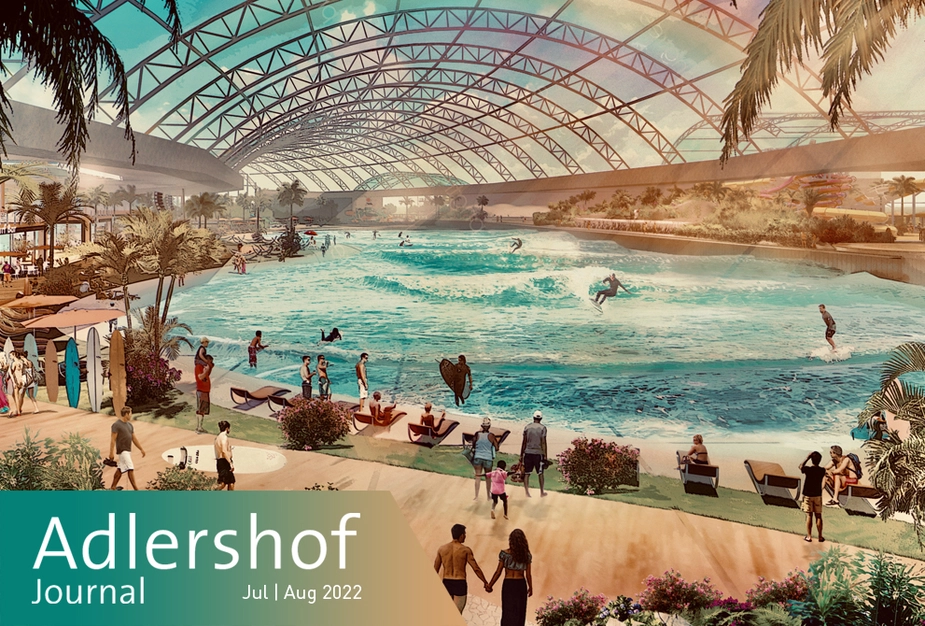The perfect wave
SURF ERA is bringing the ocean into the city
“I'm just a surfer who wanted to build something that would allow me to surf longer.” This quote is attributed to Jack O’Neill, who was not only a passionate surfer from the Santa Cruz area in California but also a talented entrepreneur. In 1952, he founded O’Neill, a manufacturing company known for its surf and sportswear. The similarities to Eirik Randow are uncanny: He got infected with the surfing virus in Santa Cruz as an exchange student and never looked back. Today, he, too, is using SURF ERA to build something that will allow him and many others to surf longer: He is bringing the ocean into the city.
The history of wave-riding goes back to Polynesia. Cave paintings from the 12th century show people gliding across the ocean waves. As a seafaring nation, the Polynesians brought the sport to Hawaii in the early 19th century, where it proliferated. To Hawaiians, surfing was not only a sport but also an important part of their religion. The diary of the English explorer James Cook contains the first written record of the history of surfing.
Famous travel writers such as Mark Twain or Jack London wrote about the wave-based sport and gave it increasing attention among the public. Today, surfing is a widespread sport and not limited to a small group of extreme athletes anymore. It’s all about that magical feeling of being carried by a wave – and being completely in tune with oneself and nature. According to the International Surfing Association, ISA, 35 million people surf worldwide. It has become an Olympic sport and in Germany, too, 500,000 people are serious followers that surf regularly. However, they have a problem. To do so, they must travel to where the waves are. Eirik Randow, too, has been doing the same tour now for years: France, Spain, Portugal. Always looking for that perfect wave. Now he wants to bring the ocean to the German capital with its first surf and water sports park.
Randow studied sports science and business at Humboldt-Universität zu Berlin (HU). And so, it was natural to also look at his favourite hobby from an academic viewpoint. “The project idea was born out of passion,” he explains. SURF ERA is a hitherto unique hybrid of surf and amusement park. At its heart is a roofed wave pool with 10,000 square metres of water and endless surf technology.
Wave pools were, in fact, invented in Berlin. In 1967, the Berlin-based researchers Siegfried Schuster and Christian Boes developed a system that created waves to test their effect on the hulls of ships. An American company licensed the technology and developed it commercially for the construction of wave pools.
The SURF-ERA wave pool can generate waves of various shapes and heights, from 30 centimetres up to 2.2 metres. The waves are generated every eight seconds and so up to 100 surfers can ride waves at the same time in the 150-metre pool. For comparison: Other indoor surf pools currently under development have pools that are typically between nine and twelve metres. “It’s not the same, bit like comparing a VW Golf with a BMW 7,” says the alumni of Humboldt-Innovation about the dimensions. The wave pool on a total of six hectares is complemented by other attractions such as a beach, a boulder for climbing, a skate park, cafés, restaurants, hotels, co-working spaces, and wellness facilities. However, it is not only size that makes SURF ERA unique. The roof can be opened like the roof of a convertible and serves as a thermal envelope when closed. The facility is planned to work without using fossil fuels and to generate enough energy using renewable energy to cover all its operations. True to the motto uttered by Kelly Slater, another famous surfer: “I believe that when surfers become surfers, they almost have a duty to become environmentalists, too.”
“The plans,” Randow tells us, “have kept changing since the launch in 2019.” This is not unusual for a project of this scale. The next step is buying land. This is a milestone, says Randow, because it will start turning a “dream” into an “active project”.
Until then, Randow must tackle several challenges. This summer, he won’t travel to surf in the sun but to Norway. The sea off the coast of Lofoten is about 500 meters deep and beckons with extremely high waves – and icy temperatures.
Rico Bigelmann for Adlershof Journal

